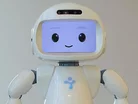Robot QT faces a classroom challenge of keeping kids focused

Researchers in Canada have put robots to work, helping keep children with learning disabilities focused on their work. And the University of Waterloo's new study found both the youngsters and their instructors valued the positive classroom contributions made by the robot, highlighting opportunities for private-sector contributions to public-sector education.
“There is definitely a great potential for using robots in the public education system,” says report co-author Kerstin Dautenhahn, a Professor of Electrical and Computer Engineering. “Overall, the findings imply that the robot has a positive effect on students.”
A paper on the study, User Evaluation of Social Robots as a Tool in One-to-One Instructional Settings for Students with Learning Disabilities, was presented at the International Conference on Social Robotics in Florence, Italy.
Dautenhahn has been studying robotics in the context of disability for many years, and her research projects incorporate principles of equity, inclusion, and diversity.
Students with learning disabilities may benefit from additional learning support, such as one-on-one instruction and using smartphones and tablets. Educators have explored using social robots to help students learn, but most research has focused on children with Autism Spectrum Disorder. As a result, there has been little investigation into using socially assistive robots for students with learning disabilities.
QT the robot faces an educational challenge
To address this gap, Dautenhahn and a team of researchers from the University of Waterloo and the Learning Disabilities Society in Vancouver conducted a series of tests with a small humanoid robot called QT. The robot's ability to perform gestures using its head and hands, along with its speech and facial features, makes it ideal for working with children with learning disabilities.
The researchers divided 16 students with learning disabilities into two groups. In one group, students received one-on-one instruction from an instructor only. In the other group, the students worked with an instructor and a QT robot. The robot was directed by the instructor using a tablet and autonomously performed various activities using its speech and gestures.
While the instructor controlled the sessions, the robot took over at certain times, triggered by the instructor, to lead the student. The robot introduced the session, set goals, and provided self-regulating strategies, if necessary. If the learning process was getting off-track, the robot used games, riddles, jokes, breathing exercises, and physical movements to redirect the student back to the task.
Students who worked with the robot were generally more engaged with their tasks and could complete them at a higher rate than those who were not assisted by a robot. The researchers plan to conduct further studies using the robot.
“Our qualitative analysis suggests that instructors and students showed positive attitudes towards the social robot in their one-to-one sessions,” the authors wrote in the report. “In addition, the students were more engaged with their task in the presence of the robot, and displayed fewer off-task behaviours in the intervention condition, compared to the control condition.
“These results suggest that a social robot can be used as an effective educational tool for instructors in boosting engagement and mitigating off-task behaviours for students with learning disabilities.”
